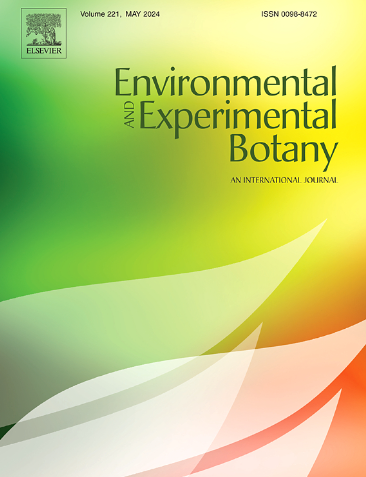Elevated nitrogen supply enhances the recovery capability of alfalfa following rewatering by regulating carbon allocation
IF 4.5
2区 生物学
Q2 ENVIRONMENTAL SCIENCES
引用次数: 0
Abstract
Drought events are increasingly frequent, posing a significant threat to plant growth and survival. Nitrogen (N) has been shown to improve drought tolerance in plants, but its role in facilitating recovery growth following rewatering after drought stress remains poorly understood. The alfalfa cultivated under hydroponic conditions with varying levels of N (Low N: 1 mM; Medium N: 4 mM; High: 7 mM) was subjected to drought-rewatering which was simulated by the addition and subsequent removal of PEG from the nutrient solution. The allocation of biomass (R/S) and non-structural carbohydrates (NSC) between shoots and roots, and the percentage of assimilation allocated to NSC were investigated at the end of the drought, early stage (7 days post-rewatering), and late stage of rewatering (35 days post-rewatering). The results revealed that after 35 days of rewatering, the alfalfa grown under medium N level had fully recovered its growth to that of their well-watered control groups, with no significant difference in total dry weights; nevertheless, those grown under low and high N levels had total dry weights that were 18.3 % and 18.8 % lower than those of their corresponding control groups, respectively. Following rewatering, similar to the drought period, plants exposed to higher N levels tended to allocate more biomass and NSC toward roots rather than shoots. At 35 days after rewatering, the R/S of plants under the low N supply level decreased by 9.6 %; that of plants under the medium N supply did not change significantly; whereas that of plants under the high N supply increased by 46.6 % in comparison with their corresponding control group. Furthermore, a higher N supply level facilitated carbon allocation for tissue growth rather than reserving NSC, similar to the effect of N supply during the drought period. Therefore, a higher N supply may enhance the recovery capability of the plant after rewatering but may delay the recovery rate. During various stages of the drought-rewatering process, increasing the N supply level influenced the allocation of biomass and NSC between shoots and roots through different key enzymes and sucrose transporters. Our study provides valuable insights into the carbon regulatory mechanisms utilized by plants in response to rewatering after drought under varying N supply conditions. This contributes to a deeper understanding of plant adaptation strategies in the face of drought events.
增加氮素供应通过调节碳分配来提高苜蓿复水后的恢复能力
干旱事件日益频繁,对植物生长和生存构成重大威胁。氮(N)已被证明可以提高植物的抗旱性,但其在促进干旱胁迫后复水后恢复生长中的作用仍知之甚少。不同N水平水培条件下栽培的紫花苜蓿(低N: 1 mM;中N: 4 mM;高:7 mM)通过添加和随后从营养液中去除PEG来模拟干旱复水。在干旱结束、复水前期(复水后7 d)和复水后期(复水后35 d),研究了根系和茎间生物量(R/S)和非结构性碳水化合物(NSC)的分配以及分配给NSC的同化比例。结果表明:补水35 d后,中等氮水平下生长的紫花苜蓿的生长已完全恢复到水分充足的对照组,但总干重差异不显著;低氮和高氮处理下的总干重分别比对照组低18.3 %和18.8 %。再浇水后,与干旱期相似,暴露于高氮水平的植物倾向于将更多的生物量和NSC分配给根而不是芽。在复水后35 d,低氮供给水平下植株的R/S下降了9.6% %;中氮处理下植株的光合速率变化不显著;高氮处理植株的光合速率比对照组提高了46.6 %。此外,较高的氮素供应水平促进了组织生长的碳分配,而不是保留NSC,这与干旱期氮素供应的效果相似。因此,较高的施氮量可以提高植株复水后的恢复能力,但可能会延迟恢复速度。在干旱复水过程的各个阶段,增加氮素供应水平通过不同的关键酶和蔗糖转运体影响生物量和NSC在茎和根之间的分配。我们的研究为了解植物在不同氮供应条件下对干旱后复水的碳调节机制提供了有价值的见解。这有助于更深入地了解植物在面对干旱事件时的适应策略。
本文章由计算机程序翻译,如有差异,请以英文原文为准。
求助全文
约1分钟内获得全文
求助全文
来源期刊

Environmental and Experimental Botany
环境科学-环境科学
CiteScore
9.30
自引率
5.30%
发文量
342
审稿时长
26 days
期刊介绍:
Environmental and Experimental Botany (EEB) publishes research papers on the physical, chemical, biological, molecular mechanisms and processes involved in the responses of plants to their environment.
In addition to research papers, the journal includes review articles. Submission is in agreement with the Editors-in-Chief.
The Journal also publishes special issues which are built by invited guest editors and are related to the main themes of EEB.
The areas covered by the Journal include:
(1) Responses of plants to heavy metals and pollutants
(2) Plant/water interactions (salinity, drought, flooding)
(3) Responses of plants to radiations ranging from UV-B to infrared
(4) Plant/atmosphere relations (ozone, CO2 , temperature)
(5) Global change impacts on plant ecophysiology
(6) Biotic interactions involving environmental factors.
 求助内容:
求助内容: 应助结果提醒方式:
应助结果提醒方式:


